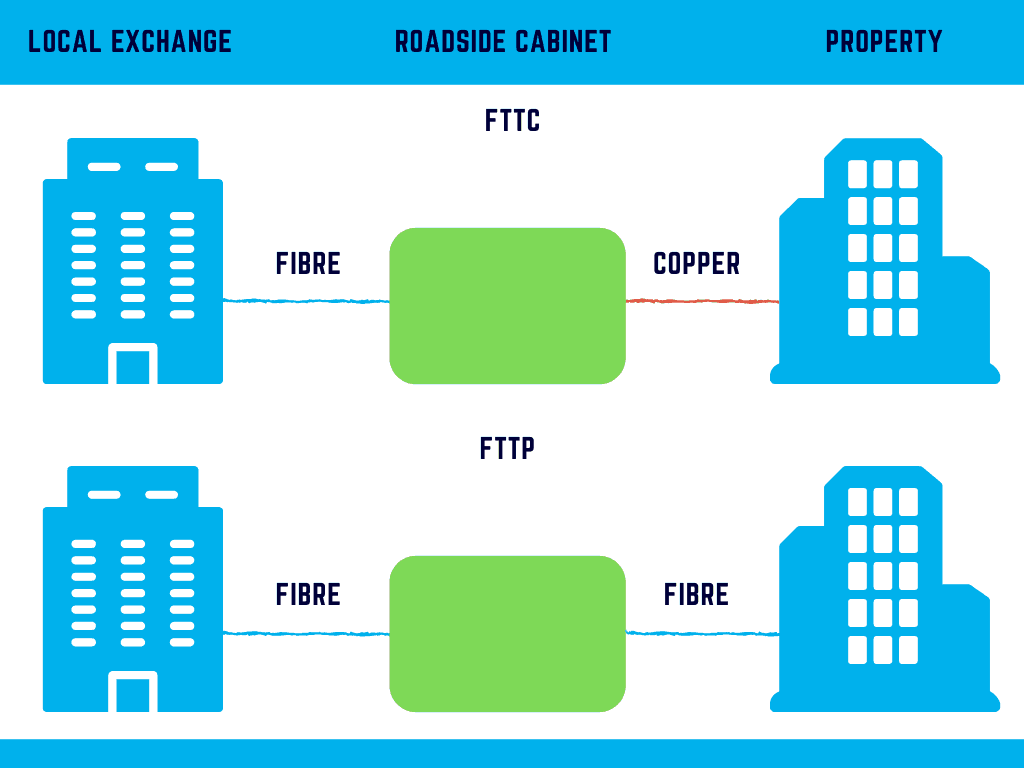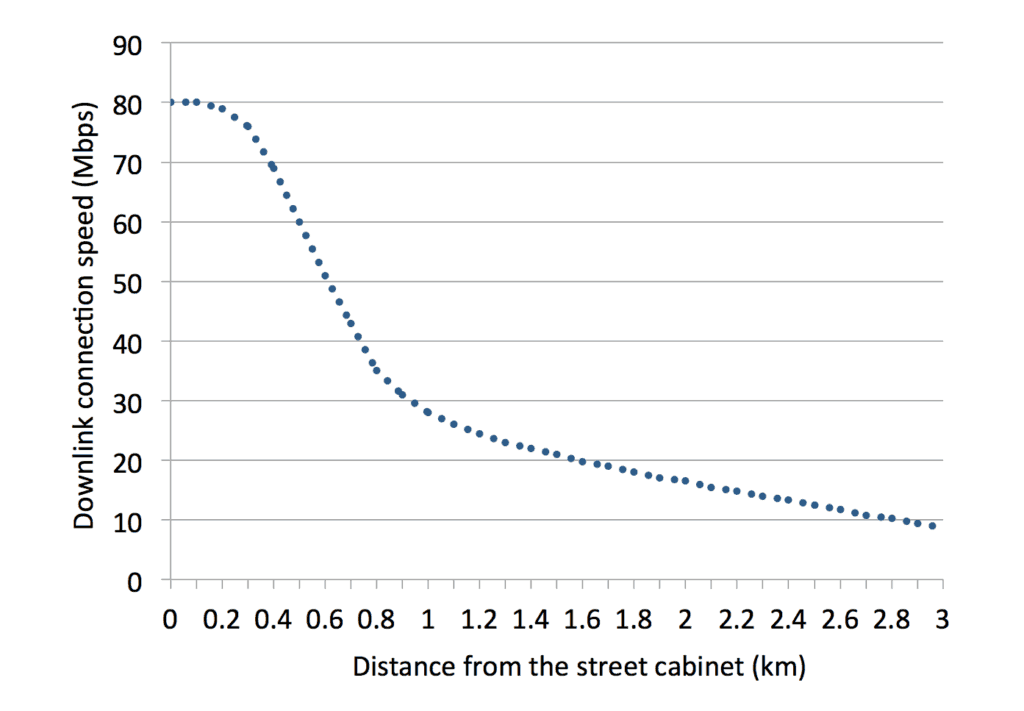Is your business looking into superfast business broadband? Then you might have heard of FTTC and FTTP. Fibre to the cabinet and fibre to the premises are two examples of superfast internet circuits available in the UK. However, are you asking which of the two is better?
Is FTTP Better Than FTTC? Yes, FTTP is better than FTTC. FTTP offers downstream speeds of up to 1Gbps, whereas FTTC offers downstream speeds of up to 80Mbps.
You might wonder why fibre to the premises is so much better than fibre to the cabinet. I will explain all you need to know about the differences between them.
FTTC v FTTP: What’s The Difference?
Here’s a diagram that digestibly shows the main difference between FTTC and FTTP: the infrastructure used to establish each internet circuit.

FTTC: FTTC combines fibre optic cable and copper wire to provide connectivity to properties. Fibre optic cable runs from the local exchange to a cabinet (the green boxes you’ll see on the street). Copper wire then runs from the cabinet to your property to provide you with a voice and data connection.
FTTC is available to 95% of the UK, so chances are it’s available to your business. Although FTTC is capable of speeds up to 80Mbps, your distance from the roadside cabinet impacts the speeds you’ll experience. Since old copper wire carries the data from the cabinet to your property, the further away you are, the slower your internet.
FTTC uses existing infrastructure to provide connectivity. It is often cheaper to install than FTTP because the infrastructure is available and ready to use.
FTTP: Fibre to the premises is a full fibre connection. FTTP doesn’t combine fibre and copper; it uses full fibre optic from the exchange to your property. It is the fastest internet circuit available unless you opted for a leased line.
Don’t get your hopes up about upgrading to FTTP just yet. FTTP is only available to approximately 3% of the UK, according to a 2017 OFCOM report. This means that FTTP might not even be available to your business yet, depending on the area that you are based in. The UK government has set a target of rolling out to 15 million premises by 2025, with full coverage available by 2033. If you want to find out whether or not FTTP is available to your business, you can find out for free here.
FTTP replaces most of the existing infrastructure, which is the reason it isn’t widely available at the moment. Installing FTTP often requires extensive work, such as digging up footpaths and roads.

Is FTTP More Expensive Than FTTC?
A fibre to the premises internet circuit offers far greater speeds than fibre to the cabinet, but how much does the price differ?
Fibre to the premises costs more than fibre to the cabinet, and the installation costs could be higher too. However, you’ll have a reliable, full-fibre connection that your business can rely on. I personally would choose fibre to the premises over fibre to the cabinet any day of the week. Particularly now fibre to the premises is becoming more affordable and widely available.
The price that you’ll pay for your broadband will differ on factors such as your location, the length of your contract, and whether or not you have an SLA in place. You can expect to pay around £50 per month for fibre to the cabinet in most UK locations. For FTTP, you can expect to pay around £90 per month in most locations.
In short, yes, fibre to the premises is more expensive than FTTP. While it is more expensive, you’re paying for a reliable connection offering brilliant speeds.
Is FTTC Any Good?
There are plenty of business broadband choices available. With that in mind, you might be wondering whether FTTC is actually any good. Although FTTC is one of the standard offerings now available, it is a superfast connection.
The speeds of an FTTC connection can differ due to numerous factors. For example, the bandwidth available to your business will lower the further you are from the roadside cabinet. If the roadside cabinet is close to your property, you’ll enjoy superfast speeds constantly. The further away from the roadside cabinet, the slower your internet. This is because a copper connection joins your property and the roadside cabinet. Copper carries data slowly, so the longer the wire the slower your internet will be.
As I said earlier in this blog post, FTTC is widely available in the UK. Approximately 95% of the UK have speeds of 30Mbps+ available to them, according to Broadband Genie. Speeds of 30Mbps and above are likely enough for most businesses in the UK that only use the internet lightly.
How Fast Is FTTC?
Internet service providers advertise FTTC speeds of up to 80Mbps downstream and 20Mbps upstream. The true speeds available to your business with fibre to the cabinet differ greatly depending on several factors, such as:
- Your distance from the roadside cabinet
- The number of businesses using internet in your area
There are other factors that impact FTTC speeds, such as electromagnetic interference. Here’s why the above factors impact the speeds you’ll enjoy with FTTC, and how much of an impact they actually have.
Your Distance From The Roadside Cabinet
Your distance from the roadside cabinet has the biggest impact on the speeds available to your business. As I said earlier in this blog post, the nearer your property to the cabinet, the greater the speeds available to your business.
This informative graphic from Increase Broadband Speed demonstrates how speeds available can differ based on your distance from the roadside cabinet.

As you can see from the graph, speeds drop off very quickly. Only 1km from the street cabinet and you’ll have a maximum downstream speed of around 30Mbps.
Technology has improved since the creation of the above graph, but the fall in speeds as shown on the graph is still a big issue for businesses using fibre to the cabinet.
The Number of Businesses Using Internet In Your Area
If there are several businesses in your area that are serviced by the same roadside cabinet that you are, at peak times you’ll find the performance of your internet might be very poor. Why? Because of contention.
Fibre to the cabinet is a contended broadband service. This means you are sharing the line with several other businesses in the area. If other businesses in your area are hogging bandwidth, you’ll have poor internet speeds.
Although you might enjoy the maximum speeds available at off-peak times, you’ll find that between 9 – 5, your broadband might be unreliable.
How Do I Increase My FTTC Speed?
Is your FTTC connection too slow? I know that a lot of businesses have to deal with this issue. Fortunately, you can improve your FTTC speed in multiple ways, such as:
- FTTC Bonding
- G.Fast Technology
FTTC Bonding
Bonded FTTC can provide faster and more reliable broadband for your business.
With bonding technology, telecom providers can combine several individual FTTC connections to create one integrated service. This means increased bandwidth and superior speeds for an inexpensive price.
FTTC bonding is one way that you can increase FTTC speeds.
G.Fast Technology
G.Fast is a relatively new technology that can be applied to the copper line at the roadside cabinet. G.Fast technology will drastically increase the speeds available to your business.
G.Fast technology is rapidly rolling out across the UK and is a better option for businesses than standard FTTC. Installation is simple, as it simply requires some modifications to how your line works in the roadside cabinet.
With G.Fast technology, you can have fibre speeds over copper wires. It’s worth noting that G.Fast won’t speed up your broadband if you’re far away from the roadside cabinet. The technology loses its effectiveness if properties are quite a distance from the cabinet, so this isn’t the best option for your business if you are.
Conclusion: Is FTTC Right For My Business?
I find the answer to this question differs based on several factors. For most businesses, standard FTTC or adapted FTTC will provide a reliable, superfast solution. For most SMEs with light internet usage and around 10 employees or less, FTTC is a brilliant option.
For larger businesses, or businesses with significant internet usage, a better solution – such as FTTP or a dedicated leased line – would be better.
I hope you found this blog post useful. If you have any questions that I haven’t answered, please leave a comment below. I’m more than happy to offer advice on any points relating to business broadband.
